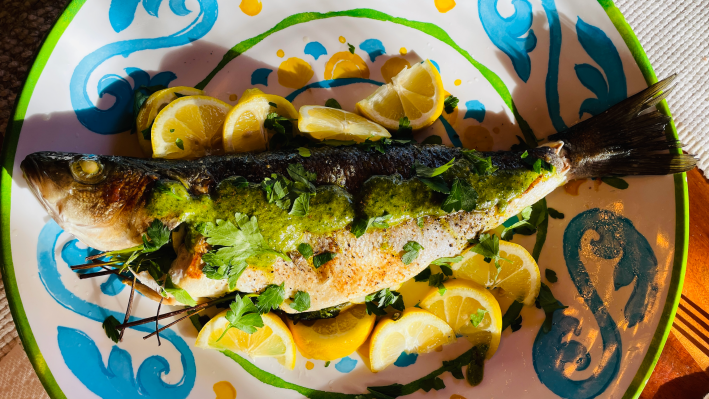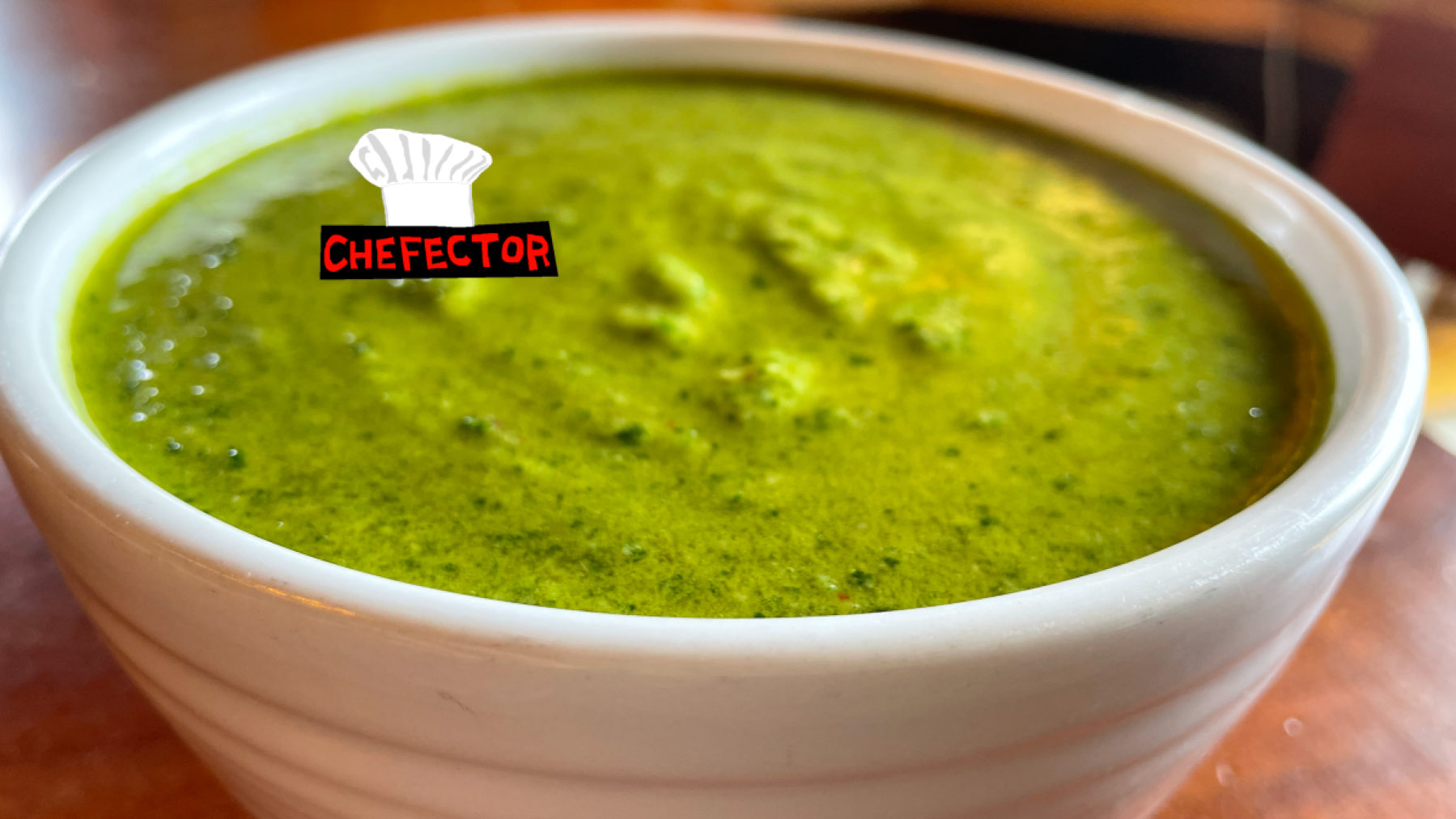It may have occurred to the canny and/or multilingual among you that "green sauce" translates to "salsa verde" in at least two romance languages: Italian and Spanish. What "salsa verde" refers to in each of those languages is different: Here in the U.S., for example, when you hear "salsa verde," it's usually in reference to the Mexican sauce based on tomatillos and hot green chili peppers. Less commonly, it can refer to the punchy Italian stuff we're making today, which is also sometimes known as bagnetto verde, which literally and hilariously and possibly disgustingly means "green baby bath." For clarity, and in deference to the Mexican stuff, and for the sake of never calling any green-colored human food "baby bath" ever gain, let's just call ours "green sauce" and move on.
There is also gremolata! That is also green and broadly saucelike and Italian, but it is a whole other thing. We're not making gremolata today. We're making green sauce. We're making this kind of green sauce.
OK. So. Green sauce. In parts of northern Italy this stuff, bright and tart and lively tasting, fresh and springlike, typically goes with boiled meat, which makes sense since boiled meat needs all the help it can get. On the other hand I am not really into boiled meat. Just the name of it. Boiled meat. No thanks man. Luckily green sauce is lovely on all types of other stuff too. As you'll see below, I particularly recommend it with roasted fish. Let's make it.
Here are some things that you will need.
You will need some herbs. A couple of fistfuls worth of leaves and tender stems of herbs. You are of course free to decide for yourself that you want your green sauce to include any assortment of herbs you like, in the sense that your own tastes and judgments probably ought to inform the cooking choices you make and also in the sense that I can't stop you from doing any particular dumb-ass thing with your green sauce. Classically the herb for this is flat-leaf Italian parsley, and that's what I recommend: All the leaves and topmost stems from a big bunch or two big bunches of flat-leaf Italian parsley. Give this all a rough chop, even if you plan on using a food processor or blender to combine everything later on; this will simply make it easier to work with.
If you simply must feel that you are Doing More, then I will look the other way while you maybe sneak an odd mint leaf or a couple of chives into the mix. That is all that I will countenance! I will not countenance frickin' chervil!
(A tip! Hang onto the leftover stems from the parsley. You're also roasting a whole fish today—didn't I mention?—and you can stuff its emptied body cavity with parsley stems and lemon slices to make it extra delicious.)
You will need some garlic. I recommend two or three or four nice big raw cloves of the stuff. Chop this also; mincing is not necessary, for now.
I am so very happy to say, without qualification or condition, that you will need some anchovy fillets, the salt-cured kind that come packed in oil in a little jar or tin. This inclusion will not surprise anyone familiar with my anchovy opinions. Anchovies are even more key an ingredient here than in, like, I dunno, arrabbiata sauce. You need anchovies. If you are using two bunches of parsley, then you will need no fewer than a half-dozen anchovy fillets. You can chop these also, if you like, but it's not necessary: Any plausible method of combining the ingredients later on will smush the anchovies into paste, no matter their initial dimensions.
You will need, oh, maybe two or three (drained) tablespoons of nonpareil capers, the intensely briny kind that come in a little jar of vinegar, per bunch of parsley. A thing that some green sauce recipes recommend is rinsing the capers in cold tap water, or soaking them for a little while in a bowl of cold tap water, to reduce their intensity. I regard this as The Coward's Path, or anyway I am too lazy to do it. Suit yourself. The green sauce is going to be vinegary either way; that's how it's supposed to be.
You'll need, let's see, a big pinch or two of hot red chili flakes. You'll need some red wine vinegar, unless you are particularly of the opinion that this should be lemon juice instead, in which case why are you reading this blog instead of doing things your own way. You'll need somewhere between a third of a cup and a cup of unseasoned breadcrumbs; less if you're using one bunch of parsley, more if you're using more parsley than that. A few grinds of black pepper would not go unwelcome in your green sauce. You probably will not need salt, what with the anchovies and the capers, but then again maybe you like things extremely salty.
You'll need some extra-virgin olive oil. Somewhere between, oh, two thirds of a cup and a cup-and-a-half of it. There will be no actual cooking involved in making this green sauce, so there is no need to worry about deforming or degrading the flavor of very fancy and delicious first-cold-pressed olive oil; there is, on the other hand, the worry that if you use crummy olive oil you will get green sauce that is more boring, less fruity and vivid and delicious, than it should be. What I am saying is to go ahead and use the best extra-virgin olive oil you can get.
I mentioned earlier that you are roasting a whole fish today. You are free not to roast a whole fish, but a roasted whole fish, in my experience, is the nicest thing to put under this green sauce, and that's what I recommend. If you can get a nice bronzino (also known as branzino, also known as European bass), gutted and scaled and with the tail and fins lopped off, then in my opinion you should go for it. Just in case you decide to do it, then also get a big ol' lemon. I will include some instructions (brief ones! This is a green sauce blog!) for cooking this sucker down below.
I think that's it. Let's see.
OK. So. You have all of this stuff. Now the only real step is to, ah, combine it. In such a way as to make it very small. Let's discuss that.
Do you have a food processor or a countertop blender? That's great. If you have a food processor or blender, chuck the parsley, garlic, anchovies, capers, chili flakes, breadcrumbs, and black pepper—everything but the olive oil, that is to say—into it. Now, pulse that sucker a few times to get all of this stuff whirred together. Splash a couple tablespoons of the vinegar in there, and do some more pulsing until everything seems pretty well combined. Now, add olive oil in a thin, slow stream, blending all the while, until you have something thickly liquid that could be spooned over, for example, a roasted fish. That's really all there is to it.
I consider it unlikely that anybody out there who does not have either a food processor or a blender does have an immersion blender. But if you should happen to be just such a unicorn, or simply prefer the idea of using your immersion blender, the procedure will be much the same, only it will take place in an immersion blender cup or jar or bowl or whatever.
Do you not have any of these things? That is fine. I suppose it is too much to hope that you have a mortar and pestle, huh. Do you have a nice sturdy mixing bowl and, like, a heavy-duty spoon? A regular spoon? The freaking heel of your palm? Do you have the ability to crush fragile food ingredients in some type of way, at all. You can still do this. The first thing to do, in this case, will be to take your knife back out and finish chopping the parsley and garlic, until they are for sure minced small as hell*. Then also mince the capers.
*A totally 100-percent optional thing you can do now with the garlic and the anchovies, and possibly with the capers as well if it sounds appealing to you, is you can kinda toss them together on your cutting board, sprinkle just a little bit of coarse kosher salt on them (the coarseness is more valuable than the saltiness, here), and smush them into a paste with the flat of your knife, by laying it on top of them flat-wise, pressing down, and kinda swiping back and forth a few times. You can also not do that at all. It's fine.
Now simply combine all of these in the big bowl, mix in the breadcrumbs and chili flakes and black pepper and vinegar, and then, very annoyingly and tediously, drizzle the olive oil in there while whisking and whisking and whisking (with a whisk) until everything looks nice and glossy and mixed together and you're satisfied that this is as close to "emulsified" as you care to get it.
There is one more step, no matter how you got to this point: Pack your nascent green sauce into a covered bowl or container and let it sit on the counter for at least a couple of hours, so that the ingredients can make friends and the oil can take on some flavor from the other stuff. That's it. You made green sauce. It was very easy.
In fact, maybe it was too easy! Maybe you are saying "What the hell am I paying this website for, so that some schmuck can tell me what things to put in the blender?" Well you can go to hell for that! But also, in the interest of comity, a thing I care deeply about, here are some quick instructions for cooking that whole bronzino.
Let the fish come to room temperature, and preheat the oven to 400 degrees. Season the inside of the bronzino with salt and freshly ground black pepper, then stuff a bunch of parsley stems and lemon slices in there. (You do not need to, like, sew this shut. It's fine for everything to be loosely contained in there.) Rub the outside of the fish with cooking oil, or hose it down with, like, the spray kind of oil, then season it with salt and pepper. Lay the fish on a foil-lined roasting pan and sock it into the oven for 10 minutes. Remove it from the oven and, carefully, turn it over with a metal fish-turner spatula (rotating the open side over the top so that it doesn't immediately dump out all its contents), then stick it back in there for another 10 minutes. If you want to be fussy about it, you can check that it has reached an internal temperature of 125 degrees before serving it.
Now a rockin' thing to do is to move the whole fish to some kind of serving tray or big plate, scoop a modest amount (it's very punchy!) of your green sauce over it for a jaunty sort of preparation, scatter some lemon wedges about, and plop that dang tray down in the middle of a table near some forks and some hunks of warm crusty bread. Station some more of the green sauce nearby just in case.

What else can you dress up with this wonderful condiment? Roasted chicken? The dreaded boiled meat? Who knows. I'll leave you to it.






